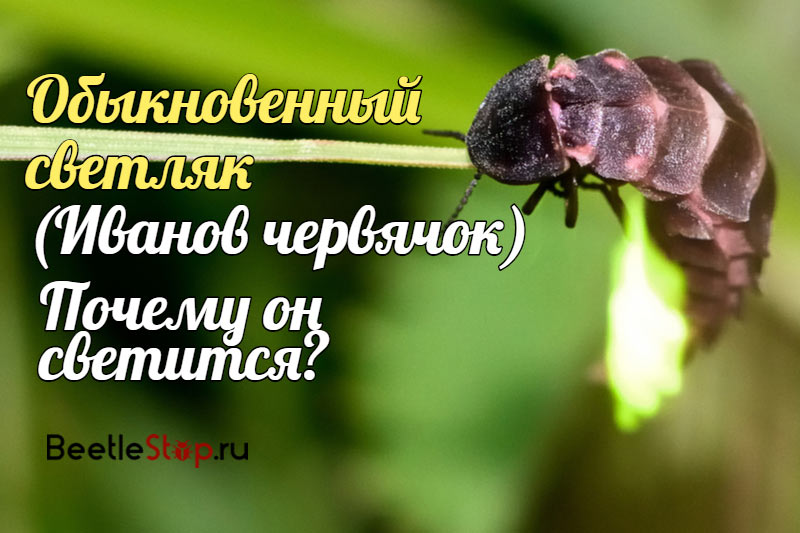Ivanov worm - a green beacon in the coastal grass
Nature endows its creations with many amazing properties, one of the most interesting and amazing is the glow. Fireflies, bugs from the same family, have the characteristic feature of emitting light. The largest number of species lives in tropical latitudes, but in the temperate zone at night beacons light up. Ivanov is a worm, so they called an ordinary firefly in Russia. Females of this species invitingly honk a greenish flashlight on their abdomen. In the dark of night, at the edge of a clearing, or on the shore of a lake, lonely lights can be seen.

Morphological description of the species
The common firefly (Lampyrisnoctiluca) belongs to the order of beetles. The length of the imago is 12-18 mm. Insects are found throughout Europe and Asia. Sexual dimorphism is pronounced:
- Male - cigar-shaped body with a size not exceeding 15 mm. The large head is covered by a pronotum. The eyes are hemispherical, the antennae are short, threadlike. The integument is soft. Dark elytra covered with punctures. The wings are transparent, fold on the back. Beetles are deprived of the oral apparatus, they do not feed, they live off the nutrients accumulated by the larval phase.
- The female is an elongated, flat body. Elytra and wings reduced. Externally, insects look like larvae. Only females of the common firefly have the ability to bioluminescent glow. Light is created by an organ located in the last three segments of the abdomen. In this area, the body cover is translucent.
Interesting fact. The insect received the name "Ivan the Worm" because of Russian belief, according to which the firefly lights the first light on the feast of Ivan Kupala (July 7).
Who shines Ivan the worm?
At night, sedentary females attract partners for mating. They can not fly in search of active males, but found an interesting way to attract attention. Females sit on the ground or climb plants. The glow lasts for two hours. If it was not possible to lure the partner, they continue to light the light for 7-10 days. Males notice a radiance when they are within a radius of 50 meters from the object. The peak of the mating season is observed in late June and early July.
Interesting fact. Males choose females with the brightest light on their abdomen. She is able to bear more eggs.
Fireflies lead a nocturnal lifestyle, for living choose forest glades, the banks of reservoirs (lakes, rivers, streams). Adults and larvae like humidity, and snails are found in such places - the favorite food for the offspring of an Ivan worm. The best time to observe fireflies is from 22 to 24 hours. The glow of insects should attract the attention of nocturnal predators, but frogs and reptiles do not touch them. This is due to the presence of poison in the body of fireflies.
Shining mechanism
To cause the body to emit a greenish-yellow radiance allows a chemical reaction. Female Lampyrisnoctiluca have a group of special cells entangled in the trachea for oxygen and nerve endings. Cells are filled with luciferin, a biological pigment that oxidizes when light appears. The released energy is almost completely consumed by luminescence, only 2% falls on heat. Reflectors of light waves are cells with uric acid crystals.Larvae can also emit a glow, but to a lesser extent.
Information. The males of the common firefly often confuse the light of an expecting partner and the light of artificial lamps.
Breeding
After mating, females proceed to oviposition. For three days they lay 50-100 eggs, placing them under moss or in grass tissue. Eggs with a diameter of 1 mm, light yellow, can glow. A germ is visible through a thin shell. Having given birth to the offspring of adults, they die. After 2-3 weeks, larvae appear. On their dark body, consisting of 12 segments, bright spots are visible, which disappear with age. The head is small, the crescent-shaped mandibles have a sucking canal. At the end of the abdomen there is a special brush to cleanse mucus from mollusks.
Predatory larvae feed on slugs and snails. The prey is several times larger than the size of hunters. The larva bites the mollusk several times and injects poison that dilutes the body. After a while, she drinks a nutritious substance. During development, the larvae molt 4-5 times. By winter, they clog under the stones and pupate. A chrysalis overwinter. In the spring a bug leaves it.
The development of the larva may drag on for several years. There have been cases of a decrease in the number of fireflies in different years associated with this factor. Destruction of the habitat, pollution or drainage of water bodies, a large amount of artificial lighting leads to the death of insects.


 (votes: 3, average rating: 4,67 out of 5)
(votes: 3, average rating: 4,67 out of 5)